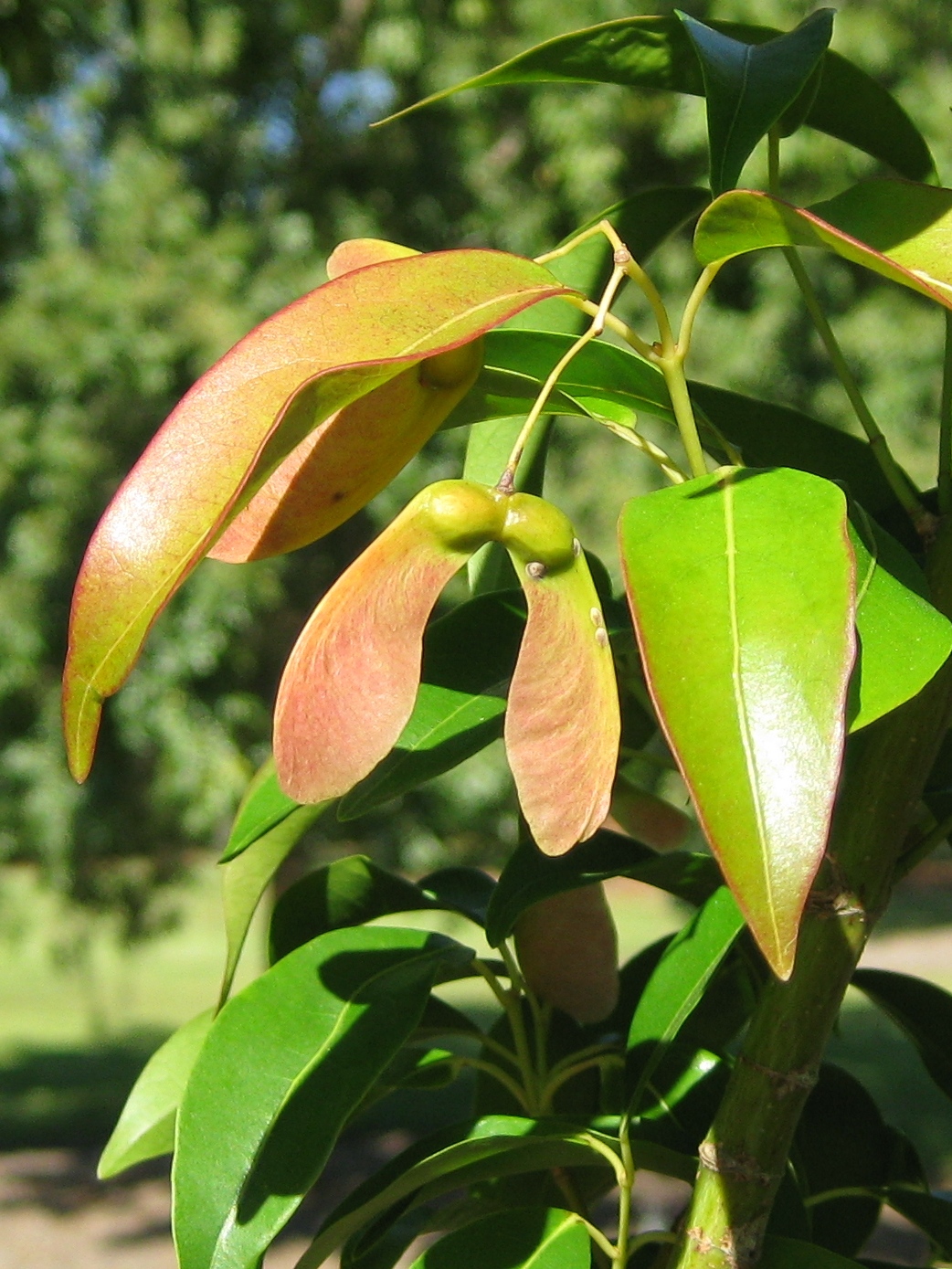
by Gary Knox | Dec 2, 2013
Acer fabri (Faber’s Maple) is unlike maples familiar to most people as it does not have the typical three or five-lobed leaves. Instead, leaves of Faber’s maple are un-lobed, slender and very glossy. In addition, most people know maple as a deciduous tree, dropping its leaves in fall, whereas Faber’s maple is evergreen.
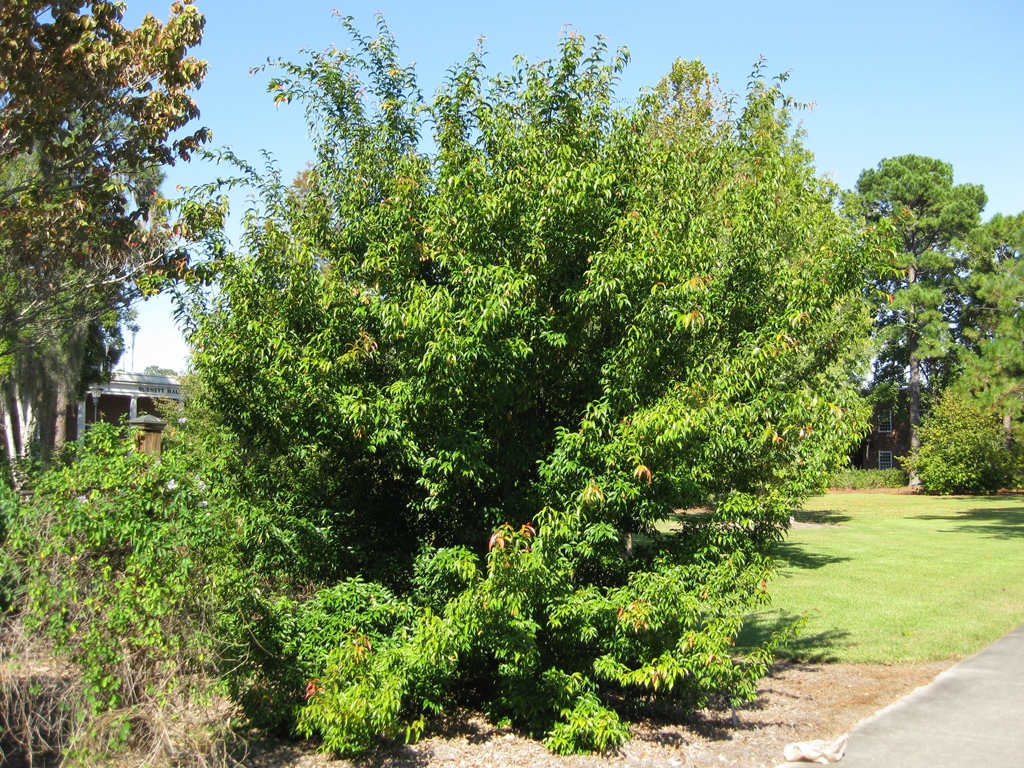
Figure 1. Acer fabri, Faber’s maple. (Photo by Gary Knox)
Faber’s maple grows as a small, broad tree up to a height of about 30 feet. Leaves on new growth are tinted red, and the familiar samaras (“helicopter” fruits), appearing in September, are also red. New growth on some trees has more red coloration than on others, suggesting the possibility of selecting forms with more red coloration. Hardiness is not confirmed but it is believed to be adapted to USDA Cold Hardiness Zones 7b-9. Leaves reportedly senesce and fall when winter temperatures drop to the low 20s or high teens (°F). Accordingly, Faber’s maple is likely to be evergreen in most of Florida and semi-evergreen after cold winters or when grown in the cooler areas of its hardiness range.
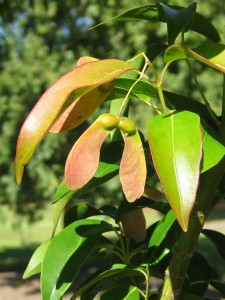
Figure 2. Closeup of the red tinted leaves and fruits of Faber’s maple. (Photo by Gary Knox)
Faber’s maple is native to mixed forests of Vietnam and central and southern China, where it is known as “luo fu feng”. This slow-growing tree fares best in partial sun and well-drained soil. No serious pests are known at this time.
The reddish new growth, glossy green leaves, red fruits and growth as a small evergreen tree collectively make this a very ornamental tree. Rare in cultivation, Faber’s maple deserves to be planted and evaluated more widely. Propagation is by seed and reportedly summer cuttings.
Acer fabri (Faber’s maple) has not yet been evaluated using the IFAS Assessment of Non-Native Plants in Florida’s Natural Areas web assessment tool. Without this assessment, the temporary conclusion is that A. fabri is not a problem species at this time and may be recommended.
by Larry Williams | Nov 18, 2013
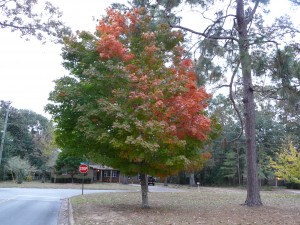
Florida maple beginning to exhibit fall color. Photo credit: Larry Williams
Although Florida is not known for the brilliant fall color enjoyed by some of our northern neighbors, we do have a number of trees that provide some fall color for our North Florida landscapes.
Our native flowering dogwood consistently provides some change in color before dropping its leaves. You can expect a red to maroon color in many of the dogwood leaves during fall.
Some of North Florida’s native maples produce good color each fall. Red maple provides brilliant red, orange and sometimes yellow leaves. The native Florida Maple, Acer saccharum var. floridum, displays a combination of bright yellow and orange color during fall. And there are many Japanese maples that provide striking fall color.
Another excellent native tree is Blackgum, Nyssa sylvatica. This tree is a little slow in its growth rate but can eventually grow to seventy-five feet in height. It deserves more use in our landscapes. It always provides a bright show of red to deep purple fall foliage.
Crape myrtle gives varying degrees of orange, red and yellow in its leaves before they fall. There are many cultivars – some that grow several feet to nearly thirty feet in height.
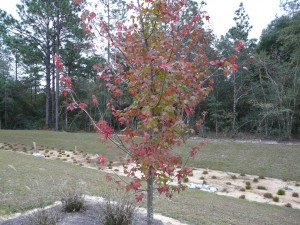
Young red maple with fall foliage. Photo credit: Larry Williams
There are a number of dependable oaks for fall color, too. Shumard, Nuttall and Turkey are a few to consider. These oaks have dark green deeply lobed leaves during summer turning vivid red to orange in fall. Turkey oak is sometimes referred to as “scrub” oak and is common on our deep sandy soils. It is short-lived as compared to most oak species, living for fifteen to thirty years before it starts to decline and die. It does not grow very large in height or trunk diameter and is not grown or sold much because it is so common in the wild. Nuttall and Shumard are becoming better available.
Sweetgum is another common native tree to considering for fall color. But some people dislike this tree because of the one to three-inch round fruit (called sweetgum balls) that it produces, which can be a nuisance as they fall on the ground around the tree. And this tree produces large surface roots that can be a problem for mowers, nearby curbs and sidewalks. But its star-shaped leaves turn bright red, purple, yellow or orange in fall.
Our native yellow poplar and hickories provide bright yellow fall foliage. And it’s difficult to find a more crisp yellow than fall ginkgo leaves.
These trees represent just a few choices for fall color. Including one or several of these trees in your landscape will allow you to enjoy the color of fall for many years right in your own backyard.
by Taylor Vandiver | Nov 11, 2013
As I made a visit back to my hometown in North Alabama I was reminded of the subtle changes from fall into winter, which are not always apparent to me living in Tallahassee: the vibrant palette of leaves as they make their permanent descent until spring, the litter of spent cotton along each highway and county road and the annual pecan harvest that has been a tradition in my family for as long as I can remember.
Due to the variations in climate and topography from upper Alabama to the panhandle of Florida, our seasons can differ greatly. However, I know of one entity that remains a constant and that is the availability of pecans. Pecan trees (Carya illinoinensis) are a common sight throughout the South. They can be spotted as far west as Texas and as far north as Illinois. The pecan tree is native to the Mississippi floodplain, which has deep, fertile, well-drained soils. Before the arrival of Europeans, Native Americans used pecans as a primary food source for thousands of years.
What’s more, pecans have major economic value. The annual value of pecans in the United States is estimated at 200 to 500 million dollars. Florida produces from five to ten million pounds of pecans annually. The majority of that pecan production acreage (6,500 acres) can be found in North Florida. While the nut is the main attractant of the tree, there’s not much that warms the heart more than seeing pecan pie at the dessert table on Thanksgiving.

A well worn recipe for southern pecan pie that has been passed down through my family.
Pecan trees are deciduous, which means that they drop their leaves in the winter. An additional consideration for those planning to install pecan trees is to be aware that they are wind-pollinated and that their male and female flowers often do not mature at the same time. Therefore, in order to ensure the possibility of high yields, two or more cultivars should be planted together for cross-pollination.
Be sure to choose a variety like ‘Elliot’ or ‘Curtis’ that has good disease resistance, is suited for North Florida and will cross-pollinate well. Plant pecans during the colder months to allow for root growth before spring. The optimum soil pH for pecans is 5.5 to 6.5. At the lower end of this range, micronutrient deficiency symptoms should be less common. Pecan trees should start producing decent crops in six to twelve years. A tree at maturity can reach up to seventy feet tall so plan spacing and placement accordingly.
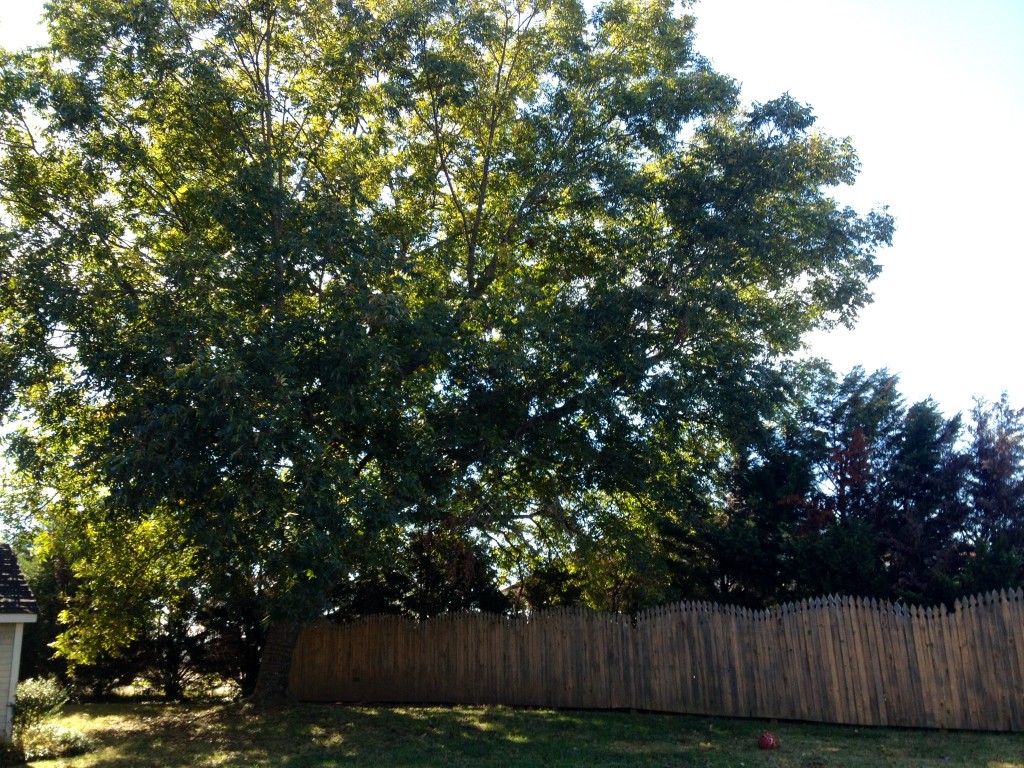
Pecan tree planted by my great-grandparents in Monrovia, Alabama.
For more information please consult Pecan Cultivars for North Florida or contact your local UF IFAS county extension office.
by Alex Bolques | Oct 25, 2013
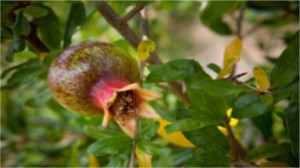 The avid gardener has heard on many occasions that fall is the best time of the year to plant trees and shrubs. Correct! Now is the time to start a fruit orchard or an edible landscape. As the seasons transition into much cooler weather, now is the ideal planting season for hardy trees, shrubs and ground covers (Trawick, 2013).
The avid gardener has heard on many occasions that fall is the best time of the year to plant trees and shrubs. Correct! Now is the time to start a fruit orchard or an edible landscape. As the seasons transition into much cooler weather, now is the ideal planting season for hardy trees, shrubs and ground covers (Trawick, 2013).
In the fall, plants require less water to get established and stress factors associated with planting in full sun are reduced. Although weather is cool, soil temperatures continue to be warm enough throughout the season to promote root growth. Thus by planting in the fall, the plant becomes more established by having a better and more vigorous root system than a plant that is planted at springtime.
Deciding what to grow sometimes is limited by what is available in a given area. Mail and online sales can be tricky if for those unaware about which fruit species perofrms best in Northwest Florida. To aid in this planning process, a link to a University of Florida IFAS publication (HS1218) is included that contains a directory of certified Florida nurseries offering fruit and nut crops. While it was developed to assist farmers locate fruit and nuts cultivars in Florida, it is helpful to begin thinking about what to grow and where to find it. The publication also lists recommended fruit and nut species and cultivars for North Florida, including north-central Florida.
Fruitscapes is a University of Florida website dedicated to fruit trees in Florida, which will increase understanding of fruit tree cultural and pest management requirements for all readers. Also explore “Temperate Fruit Crops” . Bookmark this webpage and refer to it as needed. Also, consult with your county extension office in your area.
by Les Harrison | Oct 25, 2013
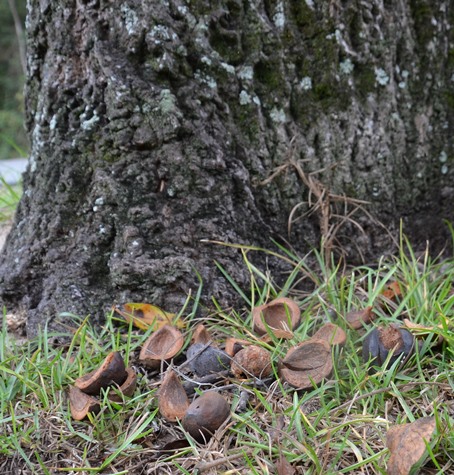
Hickory nuts are popular with squirrels in the autumn.
There is a lot to be gained from having a tough reputation. Only those with a stout disposition or lack of good sense will dare to make a challenge to the individual who hold this distinction.
Unbending, rigid and durable are descriptors which invoke a firm, if not dogmatic, state of resiliency. With this enviable identity, many compare themselves and some assimilate the traits they most admire.
Andrew Jackson is a good case in point. The seventh president grew up on the frontier, dueled with enemies, and commanded an army during the War of 1812 where he was given the nickname Old Hickory.
Like Jackson, hickories are native to North America and are highly valued for their long wearing qualities. While this president no longer visits north Florida, there are plenty of hickories growing in home landscapes.
There are three hickories in panhandle Florida, bitternut, mockernut and water. The water hickory is usually found in wetter areas and the other two species in upland sites.
This genus, Carya, is found in North America and East Asia. The term identifying this genus was coined in Greek mythology and originally referred to a woman who was transformed to a walnut tree.
Karya, or so the story goes, was the daughter of a divinely well-connected king who had gained favor with Apollo. As a courtesy, Karya and her sisters were granted the skill of prophecy from the deity.
As is typical of Greek myths and soap operas, the sisters misused their gift of divination and were punished. Karya was turned into a walnut tree by her boyfriend who was the mythological god of winemaking and ritual madness.
Legendary tragedies aside, hickory trees have a wide variety of contemporary uses commercially and environmentally.
The wood of hickories is relatively hard and is used where a durable and sturdy material are required. Tool handles and flooring are two of the most common uses today.
Prior to the development of modern composite materials, hickory lumber was utilized in vehicle parts, golf club shafts, archery equipment, and a variety of other uses which anticipated hard use. Hickory was originally used to construct baseball bats until ash gained popularity because of its lighter weight.
Hickories are an excellent specimen tree in a landscape. These tall, deciduous trees usually grow from a single trunk and provide excellent shade during the summer.
The leaves can deliver a bright yellow show in the autumn and, if planted on the south side of a home, provide passive solar heating during the cooler months. Mockernut and water hickory nuts have been used in recipes, but are difficult to crack.
One caution is not to establish a hickory near a home or other structure. Squirrels will quickly identify the nuts as a food source and can be quite messy.
Another problem issue is if a tree falls during a storm. The logs are quite heavy and will likely crush anything they hit, especially homes and vehicles.
Hickory is popular and long burning firewood. It is also widely used by bar-b-q devotees who prize the distinct flavor it imparts.
To learn more about hickory trees in north Florida , visit the nearest UF/IFAS County Extension Office or read this infromative publication on the water hickory.
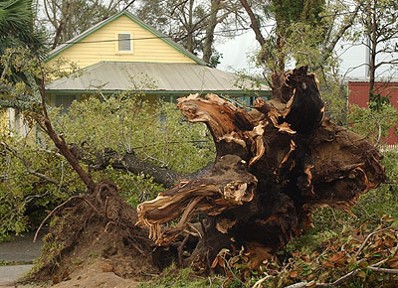
by Carrie Stevenson | Oct 7, 2013
After severe weather of any kind, homeowners must often spend a considerable amount of time dealing with impacts to their landscapes. Below are a few lessons we have learned from hurricanes and tropical storms in the past. Many thanks to fellow agent Beth Bolles for her contributions to this article.
Dealing with Toppled Trees
It may be difficult to turn an uprooted favorite tree into firewood, but this is probably the best choice. A small or young tree may be replanted successfully if done immediately. These trees will require bracing for up to two years until the root systems regrow and are able to support themselves. If the roots have been exposed for an extended period of time, don’t try and save the tree. Exposed roots should be covered with soil or moist burlap for protection from drying out. Large or older trees will typically not survive this ordeal even with the best of care. Because the root system is compromised, attempting to keep the tree may create a hazard down the road with the next storm.
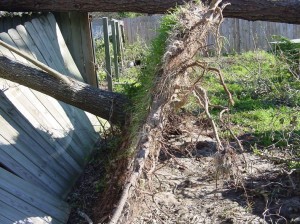
If a tree is completely uprooted, its odds of recovery are severely limited and it is best to remove the tree. Photo courtesy Beth Bolles, UF IFAS Extension
When removing fallen trees, think ahead about whether you plan to remove stumps. It’s a lot easier to pull instead of dig stumps out of the ground, so leave a four-foot stump to make your life easier. Be careful using power equipment like chain saws. It may be better to hire a professional to deal with removing large trees, especially around power lines.
Exposed Roots or Leaning Trees
Any exposed roots should be covered immediately. Cover roots with nearby soil at the same level roots were originally growing. Do not bank the soil higher because this will cut off oxygen supplies to roots in an already oxygen deprived, saturated soil.
If small trees are leaning and need straightening, they can be staked and treated like a newly planted tree. Larger trees with trunks greater than six inches in diameter can be saved but should be removed if they are a hazard to structures, power lines, or roadways. Reset the trees with stakes or guy wires for support. Trees with trunks measuring less than two inches in diameter can be supported with two or three forty-eight inch, two inch by two inch wood stakes placed one foot outside of the root ball inserted eighteen inches into the ground. Larger trees should be anchored with three or four guy wires or cables. Cover guy wires that are in contact with the trunk with rubber hoses to prevent damage.
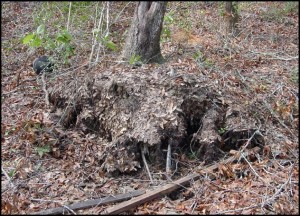
A leaning, partially uprooted tree may recover if it is righted and its roots are covered back with soil. Photo courtesty Beth Bolles, UF IFAS Extension
Replace the soil around the area and firm to assure there are no air pockets around the roots. Make sure the top root coming off the trunk is level with the existing soil. If many trees were swaying back and forth during the wind, there may be air pockets underneath the trees. If this is obvious, add soil and water to eliminate any air pockets. If root damage is obvious, do not fertilize at this time because salts in the fertilizer may damage new feeder roots.
Broken Branches
Broken branches should be removed from trees and shrubs as soon as possible to prevent tearing into trunk wood. Make clean cuts just outside of the branch collar to avoid damaging the trunk. If these are large branches, make three separate cuts to prevent tearing. Make the first cut on the underside of the branch about fifteen inches from the trunk and one-third through the branch. The second cut is made from the top, a few inches out from the first cut. This cut should remove the weight of the branch so the next one will not rip the trunk. The remaining stub can be held while the last cut is made. Make the last cut just outside the branch bark ridge and end outside the trunk collar (swollen area on lower side of branch). This is not a flush cut with the trunk and should leave a small protrusion on the trunk. Do not use wound dressing on the cut surface, as this practice is no longer recommended.
If trees lost all of their branches, it is advisable to remove the tree. The natural shape is gone and trees like pines will typically not recover. Some trees may lose the majority of their leaves, but these will flush back out so they should be okay.
Repairing Lawns
Keep a close eye on lawns for disease problems due to all the rain. Brown patch and take-all root rot would be the major concerns. Rake and remove all debris to give lawns a chance to dry out. If lawn areas are damaged, now is the time to replace with plugs or sod so they can establish before winter. Sod webworms are bad now so don’t mistake this damage for diseases. If adult moths are obvious and grass blades are closely cropped, this is due to caterpillar damage…not disease.
Watering
Most soils are saturated and irrigation systems should be in the off-mode. If there is standing water around trees or in other low areas, use a hose to siphon water to a retention pond or a better-drained area. Once soils dry out and the sun comes out, keep a close eye on plants as they may require more frequent irrigation because of root damage. Coastal areas flooded with saltwater may experience damage from extended exposure to high salinity; it is recommended to run a sprinkler system to flush out a lawn after the water retreats.
If you have questions, contact your local UF IFAS Extension Office!












